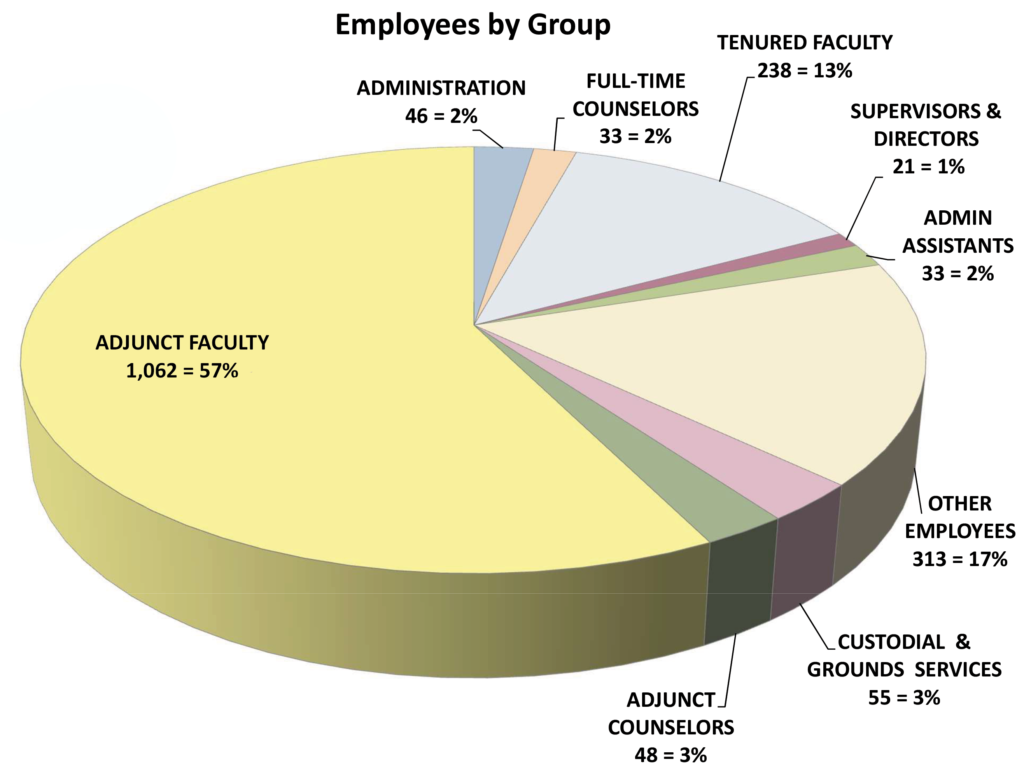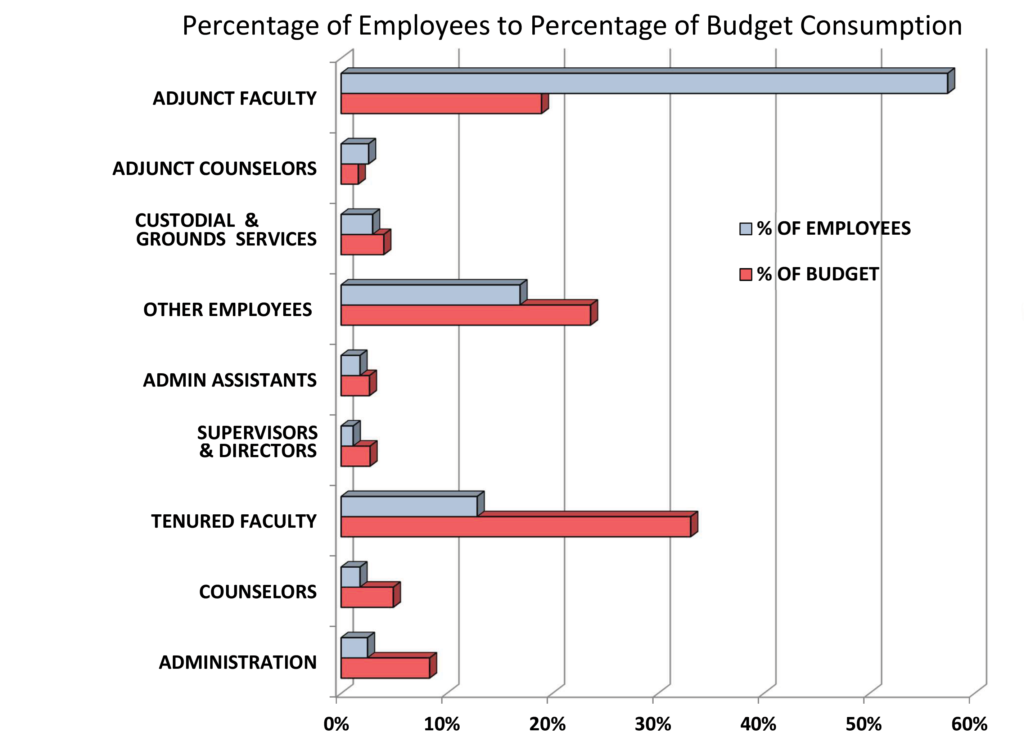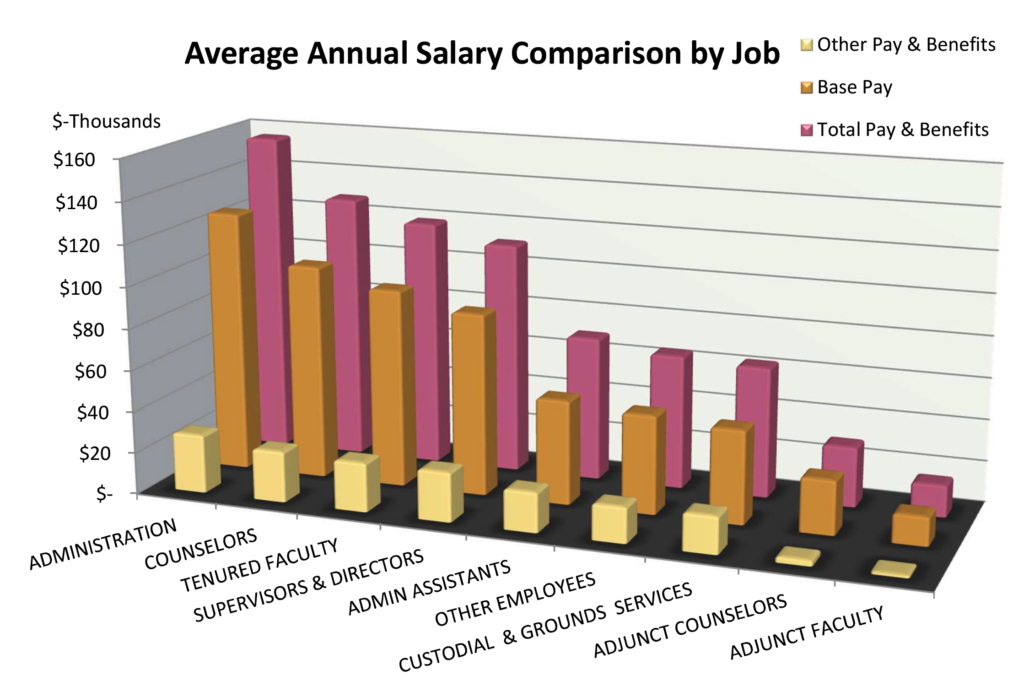
By David Milroy and members of the San Diego Adjunct Faculty Association (SDAFA)
Originally published in the CPFA Journal, Spring 2018 edition. Read more>>
As a part-time or adjunct instructor, have you ever wondered how the millions of dollars in your college’s budget are spent? Where does the money come from? Who brings in the money? Who takes home most of the money? What is your fair share for the work you do?
You may have heard that the budget for the California Community College system is in the many billions of dollars and that your own college has a budget of several hundreds of millions of dollars.
The best way to get a clear answer to the question “Where does the money go?” is to see exactly where it is spent in any given year. The clearest reporting of all community college salaries, and all salaries paid by the State of California is called “Transparent California” which can be found at transparentcalifornia.com. After you select Community Colleges, you will see all of the community colleges listed and may select reports for your college from 2012 to 2016. After selecting your college, you will see a long list of every employee in your district, from the Chancellor down to the tutor who worked for an hour that year…and everyone in between. They are listed by income from highest to lowest, and it is interesting to see which tenured faculty are keeping up with the highest paid administrators in your college. You can download this information to an Excel spread-sheet and reorganize the data by employment groups: administration, FT faculty, Classified and part-time faculty. This is a daunting task because you will find people with the title “Expert” or “Network Engineer” earning well over $100K annually and you have no idea what work they do or into which group they should go.
For this analysis, I selected the 2015 report from a typical, medium-sized college. With very few exceptions around the state, we can assume that the percentages of employees and average salaries in each group are at least similar. To simplify things, I decided to go with the groups which were easily identifiable: Administrators, FT Counselors, Tenured Faculty, Supervisors and Directors, Administrative Assistants, Custodial, Adjunct Counselors, and Adjunct Faculty. Every college labels employees differently and you may also choose to reduce the number of groups by combining all tenured faculty (instructional and counseling), Classified Employees (all non-instructional employees) and all Adjuncts (instructional and non-instructional)
However you decide to group employees, next you will want to see how many employees are in each group; what percentage of total employees they comprise; the total their group earns and what percentage of the budget accounts for each group’s total salaries.

Compare the number of Adjunct Faculty to those of other employee groups.
In Chart 1, you can see that Administrators (46) make up 2.5% of the employees, Tenured faculty (238) make up nearly 13%, Classified (201) make up about 20% and Adjuncts (1,105) account for 60% of the employees.

Compare the percent of employees by job title to the percent of the total budget spent on each group.
We can also calculate the total salaries per group and show this as a percentage of all salaries. How many people get how much of the salary budget? As shown in Chart 2, Administrators, who account for 2.5% of the employees receive 8% of the budget for salaries. Tenured Faculty who are 13% of the employees take home 33% of the salary budget, and Adjuncts, who make up a whopping 57.4% of the total employees, have to share 19% of the salary budget.

Compare compensation packages of community college employees.
How does this break down to individual salaries? In Chart 3 we see that the average total pay and benefits for Administrators is $155,760K; Tenured Faculty are close behind with an average of $119K; Classified Employees are all around $65K annually and Adjuncts come in at the bottom with an average annual total income of $15.3K
If you consider the fact that most colleges are funded by the State based on FT Students Equivalents, it is fair to say that students in classrooms being taught by faculty are the major source of college funding. If an average adjunct makes $7.5K per semester for teaching two 3-unit courses, it works out to about $3,580 per course, or if they were allowed to teach a full load of five classes, about $17,900 per semester or about $35,800 per year. Their average FT colleague who teaches five 3-unit courses per semester will earn $8.9K per course, for a total of $44.5K per semester and an annual salary and benefits of $119K, more than three times the amount an adjunct would earn for teaching the same load (if they were not forbidden from doing so by the Ed Code’s 67% load limit for PT faculty).
So, if Adjunct Faculty are 57% of the employees and teach over 50% of the classes, thereby bringing in more than 50% of the college’s funding, why do they have to share only 20% of the funds budgeted for salaries? This college’s funding is budgeted so that Tenured Faculty and Administrators can help themselves to 46% of the budget. Basically, 57% of the employees live in semi-poverty so that 37% of the employees can earn well over $100K per year.
What can be done about this situation? Looking back at Chart 1, you can see that the majority of employees are Adjunct Faculty. This means that Adjunct Faculty should be by far the majority of union members and leaders and they should have the loudest voice when it comes to negotiating salaries. Sadly, as you can also see, the other groups who benefit from this exploitation of Adjuncts have no interest in changing the status quo because they are living quite well off the cheap labor of their “part-time” colleagues.
Remember that Transparentcalifornia.com is open for anyone to use and that looking at the salary breakdown at your college could be something you could encourage your union to do. The information can be a great tool to have for negotiating better pay for adjuncts. If you would be interested in doing an analysis of your college’s salaries to see where your money goes, please contact CPFA for assistance.
